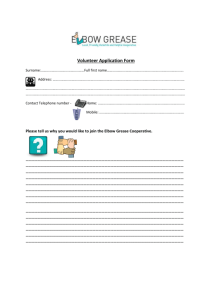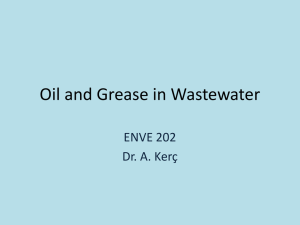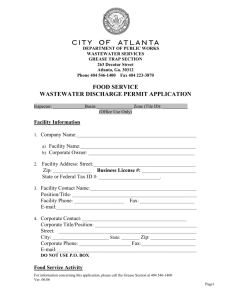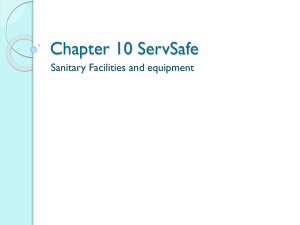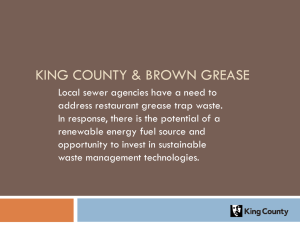FOG Management Plan Example
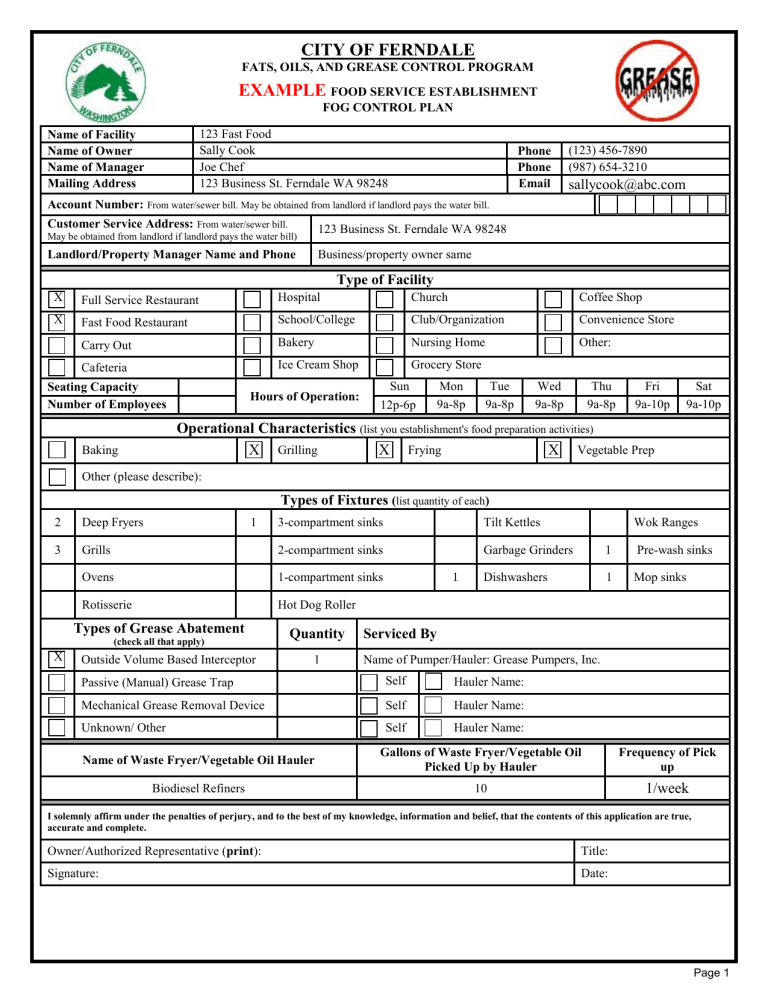
Name of Facility
Name of Owner
Name of Manager
Mailing Address
CITY OF FERNDALE
FATS, OILS, AND GREASE CONTROL PROGRAM
EXAMPLE
FOOD SERVICE ESTABLISHMENT
FOG CONTROL PLAN
123 Fast Food
Sally Cook Phone (123) 456-7890
Joe Chef
123 Business St. Ferndale WA 98248
Phone (987) 654-3210
Email sallycook@abc.com
Account Number: From water/sewer bill. May be obtained from landlord if landlord pays the water bill.
Customer Service Address: From water/sewer bill.
May be obtained from landlord if landlord pays the water bill)
123 Business St. Ferndale WA 98248
Landlord/Property Manager Name and Phone Business/property owner same
X
Full Service Restaurant
X
Fast Food Restaurant
Carry Out
Cafeteria
Seating Capacity
Number of Employees
Baking
Type of Facility
Hospital
School/College
Church
Club/Organization
Coffee Shop
Convenience Store
Bakery Nursing Home Other:
Ice Cream Shop
Hours of Operation:
Grocery Store
Sun Mon Tue Wed Thu Fri Sat
12p-6p 9a-8p 9a-8p 9a-8p 9a-8p 9a-10p 9a-10p
Operational Characteristics
(list you establishment's food preparation activities)
X Grilling X Frying X Vegetable Prep
Other (please describe):
2 Deep Fryers
Types of Fixtures ( list quantity of each )
1 3-compartment sinks Tilt Kettles Wok Ranges
3 Grills 2-compartment sinks Garbage Grinders 1 Pre-wash sinks
Ovens 1-compartment sinks 1 Dishwashers 1 Mop sinks
Rotisserie
X
Types of Grease Abatement
(check all that apply)
Outside Volume Based Interceptor
Passive (Manual) Grease Trap
Mechanical Grease Removal Device
Unknown/ Other
Hot Dog Roller
Quantity
1
Serviced By
Name of Pumper/Hauler: Grease Pumpers, Inc.
Self Hauler Name:
Self Hauler Name:
Self Hauler Name:
Name of Waste Fryer/Vegetable Oil Hauler
Biodiesel Refiners
Gallons of Waste Fryer/Vegetable Oil
Picked Up by Hauler
10
Frequency of Pick up
1/week
I solemnly affirm under the penalties of perjury, and to the best of my knowledge, information and belief, that the contents of this application are true, accurate and complete.
Owner/Authorized Representative ( print ):
Signature:
Title:
Date:
Page 1
Best Management Practices
Check each of these Best Management Practices you and your staff actively use to prevent FOG discharge to the sanitary sewer system.
X Train kitchen staff in FOG reduction techniques X Dry wipe or scrape pots, pans and dishware prior to washing
X Water temperature less than 140̊ F X Post "no Grease" signs above sinks
X
Collect waste fryer grease, grill grease, and cooking oils for recycling
X Installation of grease trap or grease interceptor
X
X
Proper food waste disposal (in trash not down drain)
X Greased covered and stored away from drains
X Drain screens installed on all drains
X
Skim or filter fryer grease daily and change the oil only when necessary
X Other:
X
X
X
Scrape and sweep up spills before using water for clean up
Routine cleaning of kitchen exhaust system filters (done in sink connected to grease retention device or professionally cleaned)
Eliminate garbage grinders
Mop water and mat cleaning water discharged to the sanitary sewer
Solid Wastes:
Oil & Grease:
Liquid Wastes:
Waste Discharge Information
(indentify how the following products are disposed of)
Sewer Trash
X
X
Recycle
X
X
X
Do you currently have a grease interceptor/trap installed?
Pretreatment
X YES NO
If " YES ", please continue the questionnaire, sign, date, and return it. If " NO ", please sign, date and return the questionnaire.
*A grease interceptor is a large underground device designed to remove fat, oil, and grease from your kitchen wastewater. A grease trap is a small, yet similar device located under the sink. These are both different from a grease-recycling bin.
1. What is the size (in gallons) of the device? 1000
2. Where is the device located? In parking lot. (not within parking area)
3. Is the device adequate and functioning as designed?
X YES
If " NO ", please explain:
NO
4. Which of the following fixtures are connected to your device? (please indicate the quantity of each)
3
Grill Tilt Kettle/Crock Pot
Oven Garbage Disposal
1
Dishwasher
Pre-rinse Sink
1
3 Bay Pot Sink
2 Bay Pot Sink
1
1
2
2
Mop Sink
Deep Fryer
Floor Drains
1
Single Bay Sink
Hand Sink
Other-specify:
5. How often is the device inspected or serviced? Once every 3 months.
6. When was the device last serviced? January 15, 2013
Page 2
7. If the device is an INDOOR grease trap, how is the waste being disposed of after cleaning?
Trash Recycle X Contractor Handles Disposal
Other-specify:
8. If a contractor services your INDOOR or OUTDOOR device, please provide the contact information for that company:
Grease Pumpers Inc, 100 Industrial Dr. Ferndale WA 98248
Phone: (360) 123-4567 Email: gpumpers@abc.com
9. Do you have receipts available? X YES NO
10. In the space provided, please describe your FOG management plan and goals based on Best Management Practices. The plan described below should represent the Best Management Practices that your facility can reasonably achieve. City of Ferndale FOG
Control program staff will review this FOG Plan.
Policy and Assurance
Fast Food 123 plans to implement and follow the Best Management Practices (BMP) guidelines pertaining to the fats, oils, and grease that are present within my facility.
Facility Type
Fast Food 123 is currently serving about 2000 meals weekly (1200 take-out). We are a fast food restaurant. We serve all food on trays (or paper bags for take-out), but all other serving ware is disposable/recyclable. We have one: three compartment sink and one dishwasher. We also have a one compartment sink used for prepping and one hand sink in the kitchen area. We have one grease interceptor in the parking lot and an outside grease barrel.
Quantities of FOG
We have two fryers, that are changed every three days or when the oil/grease is no longer clear. We use about 30 gallons of oil weekly for french fries. Grilled meat generates about 20 gallons weekly All other products served may be about another 25 gallons weekly. The estimated total grease generated weekly is 75 gallons.
Current Practices in Use for Reducing FOG
My staff and I at present properly dispose of waste (all food items are scraped into the trash prior to cleaning). We also dry wipe all dishes prior to entering the dishwasher. We use a grease collection company for our grease barrel.
They collect grease weekly. We have a properly sized grease interceptor and our grease hauler pumps it out every two months.
Proposed Changes for Further Reducing FOG
1.
Train all new employees with the BMP’s.
2.
Post No Grease signs over the one - three compartment sinks, by floor drains, next to the dishwasher. This would serve as a reminder to staff to help control the amount of grease that will be flushed down the drains to the sewer.
3.
Monitor the water temperature to ensure that it is below 140 degrees and above the accepted minimum health department standards. This will allow the grease that is entering the drain to be caught in the grease interceptor and not further down the system causing a blockage.
4.
Keep records from the grease hauling company.
5.
Discontinue the use of a degreaser that is normally poured down the drains every evening.
6.
Relocate the grease barrel so it is not near a storm drain.
7.
Have absorbent pads available for collecting oil spills (restaurant approved pads).
Policies Planned for Reducing FOG
We plan to implement all changes proposed above.
Goals and Implementation Schedule
We plan to have all changes completed within 30 days.
Page 3
11. Please sketch the layout of your kitchen, including equipment and drain locations.
Page 4
